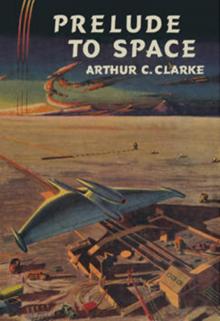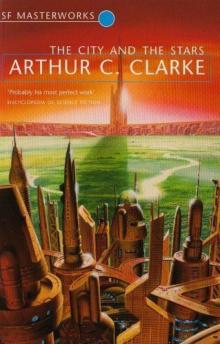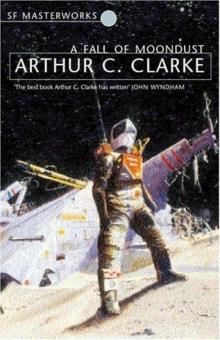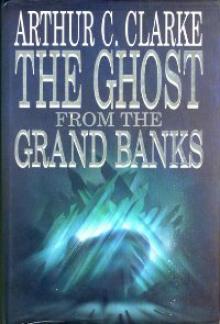- Home
- Arthur C. Clarke
Rama II r-2 Page 3
Rama II r-2 Read online
Page 3
The Soviet commander waved his arm at Heilmann. “Enough, Otto, I think that Janos is right. It has been a long day at the end of an extremely busy seventeen days of activity. This conversation will be better when we are all fresh.”
Borzov stood up. “All right, we will break for now. The shuttles will leave for the airport right after dinner.” The crew started preparing to leave. “During your short rest period,” Borzov said as an afterthought, “I want all of you to think about where we are in the schedule. We have left only two more weeks of simulations here at the training center before the break for the end-of-the-year holiday. Immediately thereafter we begin the intensive prelaunch activities. This next set of exercises is our last chance to get it right. I expect each of you to return fully prepared for the remaining work — and recommitted to the importance of this mission.”
4
THE GREAT CHAOS
The intrusion of the first Raman spacecraft into the inner solar system in early 2130 had a powerful impact on human history. Although there were no immediate changes in everyday life after the crew headed by Commander Norton returned from encountering Rama I, the clear and unambiguous proof that a vastly superior intelligence existed (or, as a minimum, had existed) somewhere else in the universe forced a rethinking of the place of homo sapiens in the overall scheme of the cosmos. It was now apparent that other chemicals, doubtless also fabricated in the great stellar cataclysms of the heavens, had risen to consciousness in some other place, at some other time. Who were these Ramans? Why had they built a giant sophisticated spacecraft and sent it on an excursion into our neighborhood? Both in public and private conversation, the Ramans were the number one topic of interest for many months.
For well over a year mankind waited more or less patiently for another sign of the Ramans” presence in the universe. Intense telescopic investigations were conducted at all wavelengths to see if any additional information associated with the retreating alien spaceship could be identified. Nothing was found. The heavens were quiet. The Ramans were departing as swiftly and inexplicably as they had arrived.
Once Excalibur was operational and its initial search of the heavens turned up nothing new, there was a noticeable change in the collective human attitude toward that first contact with Rama. Overnight the encounter became a historical event, something that had happened and was now completed. The tenor of newspaper and magazine articles that had earlier begun with phrases like “when the Ramans return…” changed to “if there is ever another encounter with the creatures who built the huge spaceship discovered in 2130…” What had been a perceived threat, a lien in a sense on future human behavior, was quickly reduced to a historical curiosity. There was no longer an urgency to deal with such fundamental issues as the return of the Ramans or the destiny of the human race in a universe peopled by intelligent creatures. Mankind relaxed, at least for a moment. Then it exploded in a paroxysm of narcissistic behavior that made all previous historical periods of individual selfishness pale by comparison.
The surge of unabashed self-indulgence on a global scale was easy to understand. Something fundamental in the human psyche had changed as a result of the encounter with Rama I. Prior to that contact, humanity stood alone as the only known example of advanced intelligence in the universe. The idea that humans could, as a group, control their destiny far into the future had been a significant linchpin in almost every working philosophy of life. That the Ramans existed (or had existed — whatever the tense, the philosophic logic came to the same conclusion) changed everything. Mankind was not unique, maybe not even special. It was just a question of time before the prevailing homocentric notion of the universe was to be irrevocably shattered by clearer awareness of the Others. Thus it was easy to comprehend why the life patterns of most human beings suddenly veered toward self-gratification, reminding literary scholars of a similar time almost exactly five centuries earlier, when Robert Herrick had exhorted the virgins to make the most of their fleeting time in a poem that began, “Gather ye rosebuds while ye may! Old time is still a-flying…”
An unrestrained burst of conspicuous consumption and global greed lasted for just under two years. Frantic acquisition of everything the human mind could create was superimposed on a weak economic infrastructure that had been already poised for a downturn in early 2130, when the first Raman spaceship flew through the inner solar system. The looming recession was first postponed throughout 2130 and 2131 by the combined manipulative efforts of governments and financial institutions, even though the fundamental economic weaknesses were never addressed. With the renewed burst of buying in early 2132, the world jumped directly into another period of rapid growth. Production capacities were expanded, stock markets exploded, and both consumer confidence and total employment hit all-time highs. There was unprecedented prosperity and the net result was a short-term but significant improvement in the standard of living for almost all humans.
By the end of the year in 2133, it had become obvious to some of the more experienced observers of human history that the “Raman Boom” was leading mankind toward disaster. Dire warnings of impending economic doom started being heard above the euphoric shouts of the millions who had recently vaulted into the middle and upper classes. Suggestions to balance budgets and limit credit at all levels of the economy were ignored. Instead, creative effort was expended to come up with one way after another of putting more spending power in the hands of a populace that had forgotten how to say wait, much less no, to itself.
The global stock market began to sputter in January of 2134 and there were predictions of a coming crash. But to most humans spread around the Earth and throughout the scattered colonies in the solar system, the concept of such a crash was beyond comprehension. After all, the world economy had been expanding for over nine years, the last two years at a rate unparalleled in the previous two centuries. World leaders insisted that they had finally found the mechanisms that could truly inhibit the downturns of the capitalistic cycles. And the people believed them — until early May of 2134.
During the first three months of the year the global stock markets went inexorably down, slowly at first, then in significant drops. Many people, reflecting the superstitious attitude toward cometary visitors that had been prevalent for two thousand years, somehow associated the stock market’s difficulties with the return of Halley’s Comet. Its apparition starting in March turned out to be far brighter than anyone expected. For weeks scientists all over the world were competing with each other to explain why it was so much more brilliant than originally predicted. After it swooped past perihelion in late March and began to appear in the evening sky in mid-April, its enormous tail dominated the heavens.
In contrast, terrestrial affairs were dominated by the emerging world economic crisis. On May 1, 2134, three of the largest international banks announced that they were insolvent because of bad loans. Within two days a panic had spread around the world. The more than one billion home terminals with access to the global financial markets were used to dump individual portfolios of stocks and bonds. The communications load on the Global Network System (GNS) was immense. The data transfer machines were stretched far beyond their capabilities and design specifications. Data gridlock delayed transactions for minutes, then hours, contributing additional momentum to the panic.
By the end of a week two things were apparent — that over half of the world’s stock value had been obliterated and that many individuals, large and small investors alike, who had used their credit options to the maximum, were now virtually penniless. The supporting data bases that kept track of personal bank accounts and automatically transferred money to cover margin calls were flashing disaster messages in almost 20 percent of the houses in the world.
In truth, however, the situation was much much worse. Only a small percentage of the transactions were actually clearing through all the supporting computers because the data rates in all directions were far beyond anything that had
ever been anticipated. In computer language, the entire global financial system went into the “cycle slip” mode. Billions and billions of information transfers at lower priorities were postponed by the network of computers while the higher priority tasks were being serviced first.
The net result of these data delays was that in most cases individual electronic bank accounts were not properly debited, for hours or even days, to account for the mounting stock market losses, Once the individual investors realized what was occurring, they rushed to spend whatever was still showing in their balances before the computers completed all the transactions. By the time governments and financial institutions understood fully what was going on and acted to stop all this frenetic activity, it was too late. The confused system had crashed completely. To reconstruct what had happened required carefully dumping and interleaving the backup checkpoint files stored at a hundred or so remote centers around the world.
For over three weeks the electronic financial management system that governed all money transactions was inaccessible to everybody. Nobody knew how much money he had — or how much anyone else had. Since cash had long ago become obsolete, only eccentrics and collectors had enough bank notes to buy even a week’s groceries. People began to barter for necessities. Pledges based on friendship and personal acquaintance enabled many people to survive temporarily. But the pain had only begun. Every time the international management organization that oversaw the global financial system would announce that they were going to try to come back on-line and would plead with people to stay off their terminals except for emergencies, their pleas would be ignored, processing requests would flood the system, and the computers would crash again.
It was only two more weeks before the scientists of the world agreed on an explanation for the additional brightness in the apparition of Halley’s Comet. But it was over four months before people could count again on reliable data base information from the GNS. The cost to human society of the enduring chaos was incalculable. By the time normal electronic economic activity had been restored, the world was in a violent financial down-spin that would not bottom out until twelve years later. It would be well over fifty years before the Gross World Product would return to the heights reached before the Crash of 2134.
5
AFTER THE CRASH
There is unanimous agreement that The Great Chaos profoundly altered human civilization in every way. No segment of society was immune. The catalyst for the relatively rapid collapse of the existing institutional infrastructure was the market crash and subsequent breakdown of the global financial system; however, these events would not have been sufficient, by themselves, to project the world into a period of unprecedented depression. What followed the initial crash would have been only a comedy of errors if so many lives had not been lost as a result of the poor planning. Inept world political leaders first denied or ignored the existing economic problems, then overreacted with a suite of individual measures that were baffling and!or inconsistent, and finally threw up their arms in despair as the global crisis deepened and spread. Attempts to coordinate international solutions were doomed to failure by the increasing need of each of the sovereign nations to respond to its own constituency.
In hindsight, it was obvious that the intemationalization of the world that had taken place during the twenty-first century had been flawed in at least one significant way. Although many activities — communications, trade, transportation (including space), currency regulation, peacekeeping, information exchange, and environmental protection, to name the most important — had indeed become international (even interplanetary, considering the space colonies), most of the agreements that established these international institutions contained codicils that allowed the individual nations to withdraw, upon relatively short notice, if the policies promulgated under the accords no longer served the interests of the country in question. In short, each of the nations participating in the creation of an international body had the right to abrogate its national involvement, unilaterally, when it was no longer satisfied with the actions of the group.
The years preceding the rendezvous with the first Raman spaceship in early 2130 had been an extraordinarily stable and prosperous time. After the world recovered from the devastating cometary impact near Padua, Italy, in 2077, there was an entire half century of moderate growth. Except for a few relatively short, and not too severe, economic recessions, living conditions improved in a wide range of countries throughout the time period. Isolated wars and civil disturbances did erupt from time to time, primarily in the undeveloped nations, but the concerted efforts of the global peacekeeping forces always contained these problems before they became too serious. There were no major crises that tested the stability of the new international mechanisms.
Immediately following the encounter with Rama I, however, there were rapid changes in the basic governing apparatus. First, emergency appropriations to handle Excalibur and other large Rama-related projects drained revenues from established programs. Then, starting in 2132, a loud clamor for tax cuts (to put more money into the hands of the individuals) reduced even further the allocations for needed services. By late 2133, most of the newer international institutions had become understaffed and inefficient. Thus the global market crash took place in an environment where there was already growing doubt in the minds of the populace about the efficacy of the entire network of international organizations. As the financial chaos continued, it was an easy step for the individual nations to stop contributing funds to the very global organizations that might have been able, if they had been used properly, to turn the tide of disaster.
The horrors of The Great Chaos have been chronicled in thousands of history texts. In the first two years the major problems were skyrocketing unemployment and bankruptcies, both personal and corporate, but these financial difficulties seemed unimportant as the ranks of the homeless and starving continued to swell. Tent and box communities appeared in the public parks of all the big cities by the winter of 2136-37 and the municipal governments responded by striving valiantly to find ways to provide services to them. These services were intended to limit the difficulties created by the supposedly temporary presence of these hordes of idle and underfed individuals. But when the economy did not recover, the squalid tent cities did not disappear. Instead they became permanent fixtures of urban life, growing cancers that were worlds unto themselves with an entire set of activities and interests fundamentally different from the host cities that were supporting them. As more time passed and the tent communities turned into hopeless, restless caldrons of despair, these new enclaves in the middle of the metropolitan areas threatened to boil over and destroy the very entities that were allowing them to exist. Despite the anxiety caused by this constant Damocles” sword of urban anarchy, the world squeaked through the brutally cold winter of 2137-38 with the basic fabric of modem civilization still more or less intact.
In early 2138 a remarkable series of events occurred in Italy. These events, focused around a single individual named Michael Balatresi, a young Franciscan novitiate who would later become known everywhere as St. Michael of Siena, occupied much of the attention of the world and temporarily forestalled the disintegration of the society. Michael was a brilliant combination of genius and spirituality and political skills, a charismatic polyglot speaker with an unerring sense of purpose and timing. He suddenly appeared on the world stage in Tuscany, coming seemingly out of nowhere, with a passionate religious message that appealed to the hearts and minds of many of the world’s frightened and!or disenfranchised citizens. His following grew rapidly and spontaneously and paid no heed to international boundaries. He became a potential threat to almost all the identified leadership coteries of the world with his unwavering call for a collective response to the problems besetting the species. When he was martyred under appalling circumstances in June of 2138, mankind’s last spark of optimism seemed to perish. The civilized world that had been held t
ogether for many months by a flicker of hope and a slim thread of tradition abruptly crumbled into pieces.
The four years from 2138 to 2142 were not good years to be alive. The litany of human woes was almost endless. Famine, disease, and lawlessness were everywhere. Small wars and revolutions were too numerous to count. There was an almost total breakdown in the standard institutions of modern civilization, creating a phantasmagoric life for everyone in the world except the privileged few in their protected retreats. It was a world gone wrong, the ultimate in entropy. Attempts to solve the problems by well-meaning groups of citizens could not work because the solutions they conceived could only be local in scope and the problems were global.
The Great Chaos also extended to the human colonies in space and brought a sudden end to a glorious chapter in the history of exploration. As the economic disaster spread on the home planet, the scattered colonies around the solar system, which could not exist without regular infusions of money, supplies, and personnel, quickly became the forgotten stepchildren of the people on Earth. As a result almost half of the residents of the colonies had left to return home by 2140, the living conditions in their adopted homes having deteriorated to the point where even the twin difficulties of readjustment to Earth’s gravity and the terrible poverty throughout the world were preferred over continuing to stay (most likely to die) in the colonies. The emigration process accelerated in 2141 and 2142, years characterized by mechanical breakdowns in the artificial ecosystems at the colonies and the beginning of a disastrous shortage of spare parts for the entire fleet of robot vehicles used to sustain the new settlements.
By 2143 only a very few hard core colonists remained on the Moon and Mars. Communications between Earth and the colonies had become intermittent and erratic. Monies to maintain even the radio links with the outlying settlements were no longer available. The United Planets had ceased to exist two years previously. There was no all-human forum addressing the problems of the species; the Council of Governments (COG) would not be formed for 6ve more years. The two remaining colonies struggled vainly to avoid death.

 Time's Eye
Time's Eye The Sentinel
The Sentinel Prelude to Space
Prelude to Space Earthlight (Arthur C. Clarke Collection)
Earthlight (Arthur C. Clarke Collection) 2001: A Space Odyssey
2001: A Space Odyssey Against the Fall of Night
Against the Fall of Night Glide Path
Glide Path The Lost Worlds of 2001
The Lost Worlds of 2001 The Trigger
The Trigger Reach for Tomorrow
Reach for Tomorrow Islands in the Sky
Islands in the Sky The Songs of Distant Earth
The Songs of Distant Earth 2010: Odyssey Two
2010: Odyssey Two Childhood's End
Childhood's End 3001: The Final Odyssey
3001: The Final Odyssey The Fountains of Paradise
The Fountains of Paradise Rama: The Omnibus
Rama: The Omnibus The Hammer of God
The Hammer of God Beyond the Fall of Night
Beyond the Fall of Night Tales From Planet Earth
Tales From Planet Earth 2061: Odyssey Three
2061: Odyssey Three Tales From the White Hart
Tales From the White Hart The City and the Stars/The Sands of Mars
The City and the Stars/The Sands of Mars The Star
The Star Imperial Earth
Imperial Earth The Light of Other Days
The Light of Other Days Firstborn
Firstborn The Other Side of the Sky
The Other Side of the Sky Cradle
Cradle The Wind From the Sun
The Wind From the Sun The Ghost From the Grand Banks and the Deep Range
The Ghost From the Grand Banks and the Deep Range The Deep Range
The Deep Range Expedition to Earth
Expedition to Earth A Fall of Moondust
A Fall of Moondust Dolphin Island (Arthur C. Clarke Collection)
Dolphin Island (Arthur C. Clarke Collection) Richter 10
Richter 10 The City and the Stars
The City and the Stars Tales of Ten Worlds
Tales of Ten Worlds Dolphin Island
Dolphin Island Expedition to Earth (Arthur C. Clarke Collection: Short Stories)
Expedition to Earth (Arthur C. Clarke Collection: Short Stories) Sunstorm
Sunstorm Rendezvous with Rama
Rendezvous with Rama The Collected Stories of Arthur C. Clarke
The Collected Stories of Arthur C. Clarke Trouble with the Natives
Trouble with the Natives Rama Revealed r-4
Rama Revealed r-4 The Sixth Science Fiction Megapack
The Sixth Science Fiction Megapack Firstborn to-3
Firstborn to-3 The Ghost from the Grand Banks
The Ghost from the Grand Banks Into the Comet
Into the Comet The Fires Within
The Fires Within 2061: Odyssey 3
2061: Odyssey 3 The Ninth Science Fiction Megapack
The Ninth Science Fiction Megapack The Coast of Coral
The Coast of Coral The Ghost from the Grand Banks (Arthur C. Clarke Collection)
The Ghost from the Grand Banks (Arthur C. Clarke Collection) The Space Trilogy
The Space Trilogy A Meeting With Medusa
A Meeting With Medusa 2001: A Space Odyssey (Arthur C. Clarke Collection: The Odyssey)
2001: A Space Odyssey (Arthur C. Clarke Collection: The Odyssey) Islands in the Sky (Arthur C. Clarke Collection)
Islands in the Sky (Arthur C. Clarke Collection) Rama II r-2
Rama II r-2 Glide Path (Arthur C. Clarke Collection)
Glide Path (Arthur C. Clarke Collection) The Sixth Science Fiction Megapack: 25 Classic and Modern Science Fiction Stories
The Sixth Science Fiction Megapack: 25 Classic and Modern Science Fiction Stories Tales from the White Hart (Arthur C. Clarke Collection: Short Stories)
Tales from the White Hart (Arthur C. Clarke Collection: Short Stories) The Reluctant Orchid
The Reluctant Orchid